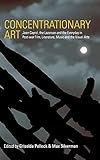Concentrationary Art : Jean Cayrol, the Lazarean and the Everyday in Post-war Film, Literature, Music and the Visual Arts / ed. by Max Silverman, Griselda Pollock.
Material type: TextPublisher: New York ; Oxford : Berghahn Books, [2019]Copyright date: ©2019Description: 1 online resource (272 p.)Content type:
TextPublisher: New York ; Oxford : Berghahn Books, [2019]Copyright date: ©2019Description: 1 online resource (272 p.)Content type: - 9781785339707
- 9781785339714
- Arts, French -- 20th century
- Arts, French -- 21st century
- French literature -- 20th century -- History and criticism
- French literature -- 21st century -- History and criticism
- Internment camps in art
- Internment camps in literature
- Nazi concentration camps in art
- Nazi concentration camps in literature
- Raising of Lazarus (Miracle) in art
- Raising of Lazarus (Miracle) in literature
- LITERARY CRITICISM / European / French
- Jean Cayrol, Concentrationary, Post-war, Frankfurt School, Hannah Arendt
- 848/.91209 23
- PQ2605.A873 Z57 2019
- online - DeGruyter
| Item type | Current library | Call number | URL | Status | Notes | Barcode | |
|---|---|---|---|---|---|---|---|
 eBook
eBook
|
Biblioteca "Angelicum" Pont. Univ. S.Tommaso d'Aquino Nuvola online | online - DeGruyter (Browse shelf(Opens below)) | Online access | Not for loan (Accesso limitato) | Accesso per gli utenti autorizzati / Access for authorized users | (dgr)9781785339714 |
Frontmatter -- Contents -- Illustrations -- Acknowledgements -- Introduction: Lazarus and the modern world -- Part I Lazarus among Us -- Lazarean Dreams -- Lazarean Literature -- Part II Situating Cayrol’s Lazarean -- CHAPTER 1 Lazarean Writing in Post-war France -- CHAPTER 2 The Perpetual Anxiety of Lazarus the gaze, the tomb and the body in the shroud -- Part III Reading with the Lazarean -- CHAPTER 3 Concentrationary Art and the Reading of Everyday Life (in)human spaces in Chantal Akerman’s Jeanne Dielman, 23, quai du commerce, 1080 Bruxelles (1975) -- CHAPTER 4 Cinematic Work as Concentrationary Art in Laurent Cantet’s Ressources humaines (1999) -- CHAPTER 5 After Haunting a conceptualization of the Lazarean image -- CHAPTER 6 Lazarean Sound the autonomy of the auditory from Hanns Eisler (nuit et brouillard, 1955) to Susan Philipsz (night and fog, 2016) -- Concluding Remarks -- Index
restricted access online access with authorization star
http://purl.org/coar/access_right/c_16ec
Largely forgotten over the years, the seminal work of French poet, novelist and camp survivor Jean Cayrol has experienced a revival in the French-speaking world since his death in 2005. His concept of a concentrationary art—the need for an urgent and constant aesthetic resistance to the continuing effects of the concentrationary universe—proved to be a major influence for Hannah Arendt and other writers and theorists across a number of disciplines. Concentrationary Art presents the first translation into English of Jean Cayrol’s key essays on the subject, as well as the first book-length study of how we might situate and elaborate his concept of a Lazarean aesthetic in cultural theory, literature, cinema, music and contemporary art.
Mode of access: Internet via World Wide Web.
In English.
Description based on online resource; title from PDF title page (publisher's Web site, viewed 25. Jun 2024)


